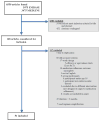Modes of delivery for interventions to improve cardiovascular medication adherence
- PMID: 21348564
- PMCID: PMC3115758
Modes of delivery for interventions to improve cardiovascular medication adherence
Abstract
Objective: To determine the optimal modes of delivery for interventions to improve adherence to cardiovascular medications.
Study design: Systematic review.
Methods: We conducted systematic searches of English-language, peer-reviewed publications in MEDLINE and EMBASE, 1966 through December 31, 2008. We selected randomized controlled trials of interventions to improve adherence to medications for preventing or treating cardiovascular disease or diabetes. Articles were classified based on mode of delivery of the main intervention as (1) person-independent interventions (mailed, faxed, or hand distributed; or delivered via electronic interface) or (2) person-dependent interventions (nonautomated phone calls, in-person interventions).
Results: We identified 6550 articles. Of these, 168 were reviewed in full and 51 met inclusion criteria. Among person-independent interventions (56% successful), electronic interventions were most successful (67%). Among person-dependent interventions (52% successful), phone calls showed low success rates (38%). In-person interventions at hospital discharge were more effective (67%) than clinic interventions (47%). In-person pharmacist interventions were effective when held in a pharmacy (83% successful), but were less effective in clinics (38%).
Conclusions: Future medication adherence studies should explore new electronic approaches and in-person interventions at the site of medication distribution. Identifying times of increased patient receptivity to the adherence message such as hospital discharge also will be important.
Comment in
-
Medication adherence: the search for interventions that work.Am J Manag Care. 2010;16(12):925-6. Am J Manag Care. 2010. PMID: 21348563 No abstract available.
References
-
- Ho PM, Spertus JA, Masoudi FA, et al. Impact of medication therapy discontinuation on mortality after myocardial infarction. Arch Intern Med. 2006 Sep 25;166:1842–7. - PubMed
-
- Ho PM, Rumsfeld JS, Masoudi FA, et al. Effect of medication nonadherence on hospitalization and mortality among patients with diabetes mellitus. Arch Intern Med. 2006 Sep 25;166:1836–41. - PubMed
-
- Rasmussen JN, Chong A, Alter DA. Relationship between adherence to evidence-based pharmacotherapy and long-term mortality after acute myocardial infarction. JAMA. 2007 Jan 10;297:177–86. - PubMed
-
- Kripalani S, Yao X, Haynes RB. Interventions to enhance medication adherence in chronic medical conditions: a systematic review. Arch Intern Med. 2007;167:540–550. - PubMed
Publication types
MeSH terms
Substances
Grants and funding
LinkOut - more resources
Full Text Sources
Medical
Miscellaneous

